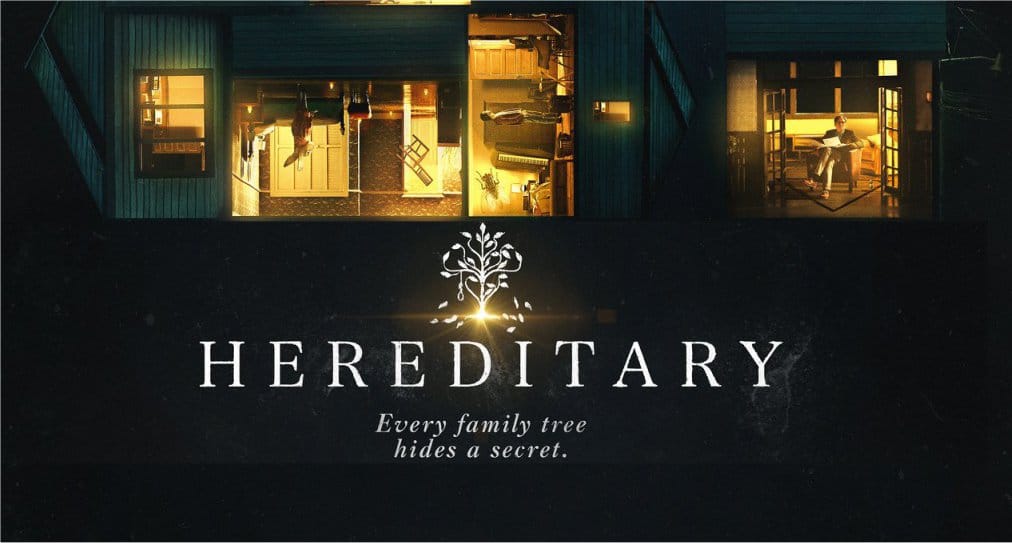 When it opened on June 8, 2018, Hereditary was already a favorite at the Sundance Film Festival. It went on to become producer A24’s most successful film. Many critics, and audience members, claimed that it was the most terrifying film of 2018. The film owes much to family dramas like Ordinary People as well as psychological horror films with a demonic element like Rosemary’s Baby and The Exorcist. And if Toni Collette doesn’t at least get an Oscar® nomination for her electrifying performance, there’s no justice.
When it opened on June 8, 2018, Hereditary was already a favorite at the Sundance Film Festival. It went on to become producer A24’s most successful film. Many critics, and audience members, claimed that it was the most terrifying film of 2018. The film owes much to family dramas like Ordinary People as well as psychological horror films with a demonic element like Rosemary’s Baby and The Exorcist. And if Toni Collette doesn’t at least get an Oscar® nomination for her electrifying performance, there’s no justice.
Hereditary is the debut feature film of Ari Aster—and what a debut! The film follows the Save the Cat! Monster in the House genre that includes a Monster, a House, and a Sin. The transgression of Annie Graham’s mother conjures an unspeakable evil into the Graham household. Let’s beat it out!
Written & Directed By: Ari Aster
MITH Type: Supra-Natural Monster
MITH Cousins: Rosemary’s Baby, The Exorcist, The Haunting, The Shining, The Witch, Get Out, The Omen, The Amityville Horror, The Exorcism of Emily Rose, Race with the Devil, Angel Heart, The Mephisto Waltz, Burnt Offerings, The Sentinel, House of the Devil, The Babadook, Paranormal Activity, The Evil Dead, Night of the Demons, Curse of the Demon, Insidious, The Conjuring, The Nun
How does Hereditary hit Blake Snyder’s story beats? Here is the Save the Cat!® beat sheet for the film:
Opening Image: After the obituary notice for 78-year-old Ellen Taper Leigh, we open on the perfect miniature of the Graham house in Annie Graham’s workroom. In a way, this informs us about seeing this particular family, the Grahams, up close and personal (along with the private hell they’re about to endure). Most of the film is framed in locked-off, long and wide shots, as if we’re peeking into the happenings inside of a doll’s house.
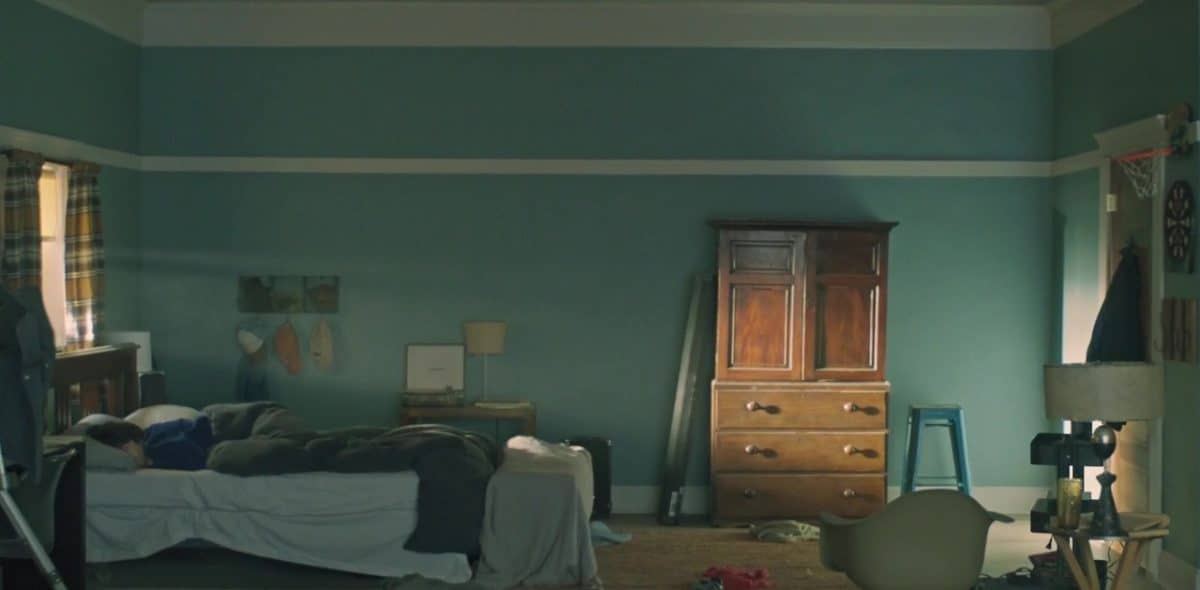
Set-Up: We meet Peter Graham (Alex Wolff), and the rest of the family, Steve Graham, the father (Gabriel Byrne); Annie Graham, the mother (Toni Collette); and 13-year-old Charlie (Milly Shapiro), who has fallen asleep again in the treehouse. They’re all late for…
Catalyst: … the funeral of their Grandma Ellen Leigh (Annie’s elderly mother). Ellen’s passing is what kicks off the story. The catalytic death will affect each member of the family, particularly Annie. Of course, we won’t know the full impact of the death and its consequences until well into the story.
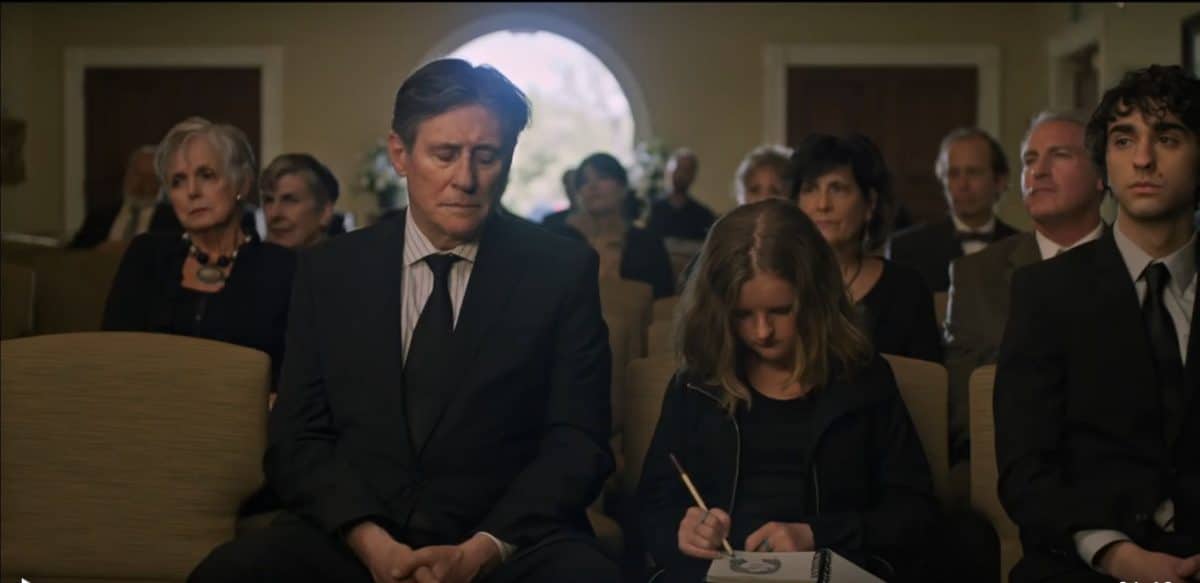
Theme Stated: Annie reads a eulogy about her intensely secretive and private mother to a smattering of guests, many of whom that she doesn’t recognize. Annie’s eulogy of her mother’s “private rituals, private friends, private anxieties” doesn’t paint her deceased mother in too good a light. This is the theme: the people we thought we knew, but really don’t. How those closest to us may harbor dark secrets (that can come back to haunt us). This is what the Graham family, particularly Annie, will come to learn. It’s also important to note that Annie and her mother, laying to rest, wear the same enigmatic gold sigil, which we’ll be seeing more; part of the “private ritual.”
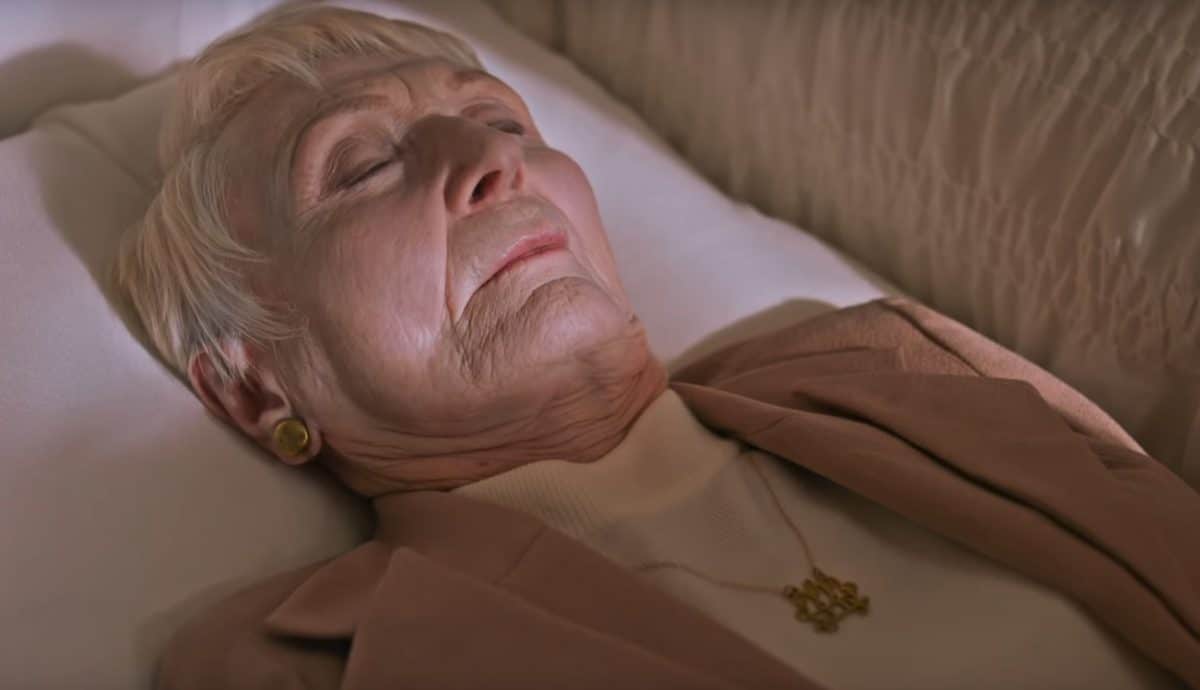
Debate: After the funeral, Annie speaks to Charlie about Grandma Ellen’s death. It’s revealed that Charlie was the favorite grandchild (even though Ellen wanted Charlie to be a boy) and that Ellen was a little too protective of her granddaughter her entire life, even trying to breastfeed her. One more wedge that divided Annie and her mother.
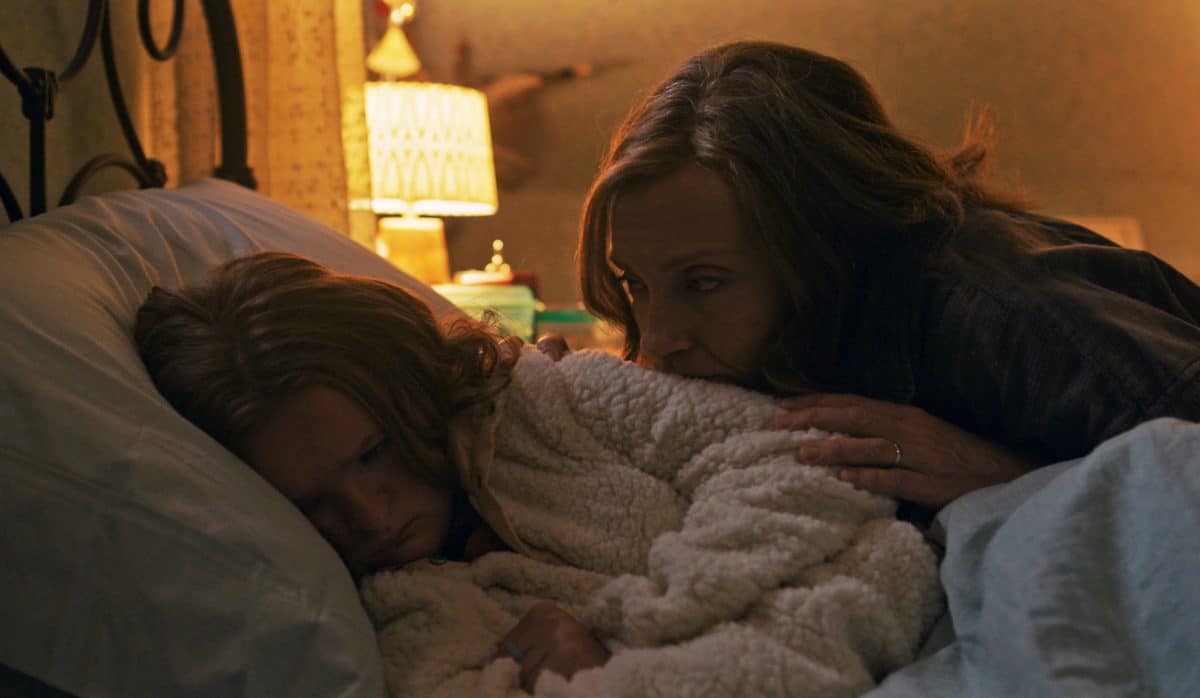
Annie works in her studio space. She’s building miniature dioramas for an art show six months away, each little doll room illustrating a biographic quality of her life (perhaps as a way of controlling the chaos in her life). As Annie finishes working for the night, she sees her dead mother watching her from the shadows, or did she?
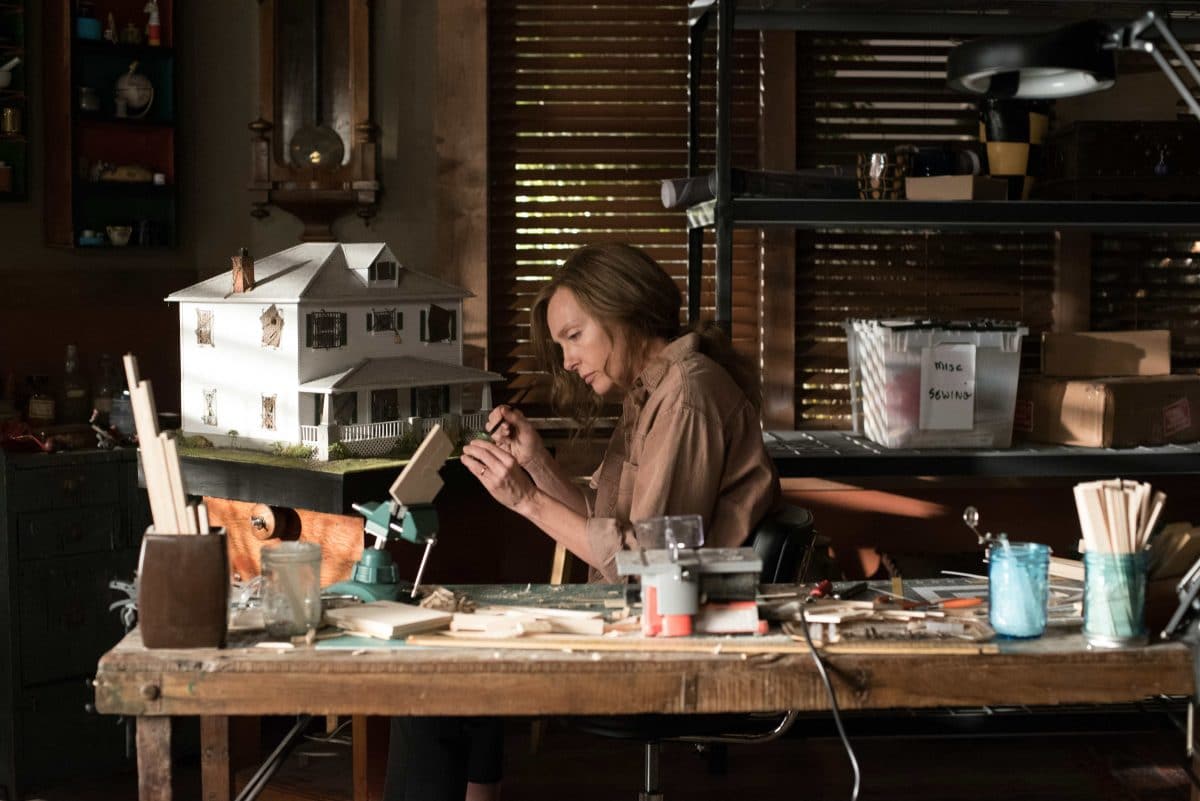
At school, Charlie, who seems lost in her own world, doesn’t seem surprised when a pigeon hits the window close to where she’s sitting. Stealing scissors from the teacher, she cuts off the dead bird’s head and uses it to make a doll (she’s into crafts). After she does this, a strange woman across the street watches her and waves. What’s that about?
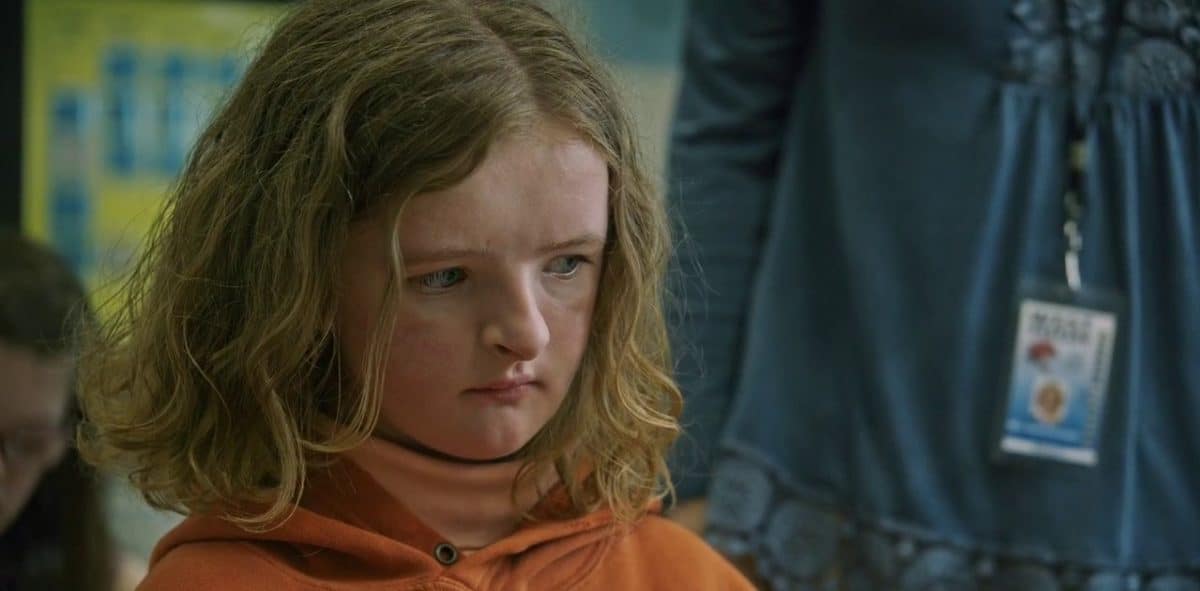
In one of Peter’s classes, there’s a discussion about Greek myths—about tragedy and about heroes being pawns through other forces. Though this school topic seems innocuous at the time, it will come into play dramatically later.
Back at home, Steve gets a call about Annie’s mom’s grave being desecrated, a fact he hides from his wife. Keeping her own secrets, Annie leaves the house, lying about going to a movie, and attends a grief recovery group. Here, she reveals the troubled childhood, violence and mental illness she endured with her mother. Her brother, at age 16, hanged himself, and in the suicide note blamed his mother for trying to “put people inside him.” Hmmmm. It’s also revealed that she kept Peter away from her mother when he was born, but felt guilty, so she let her mother “put her hooks” into Charlie.
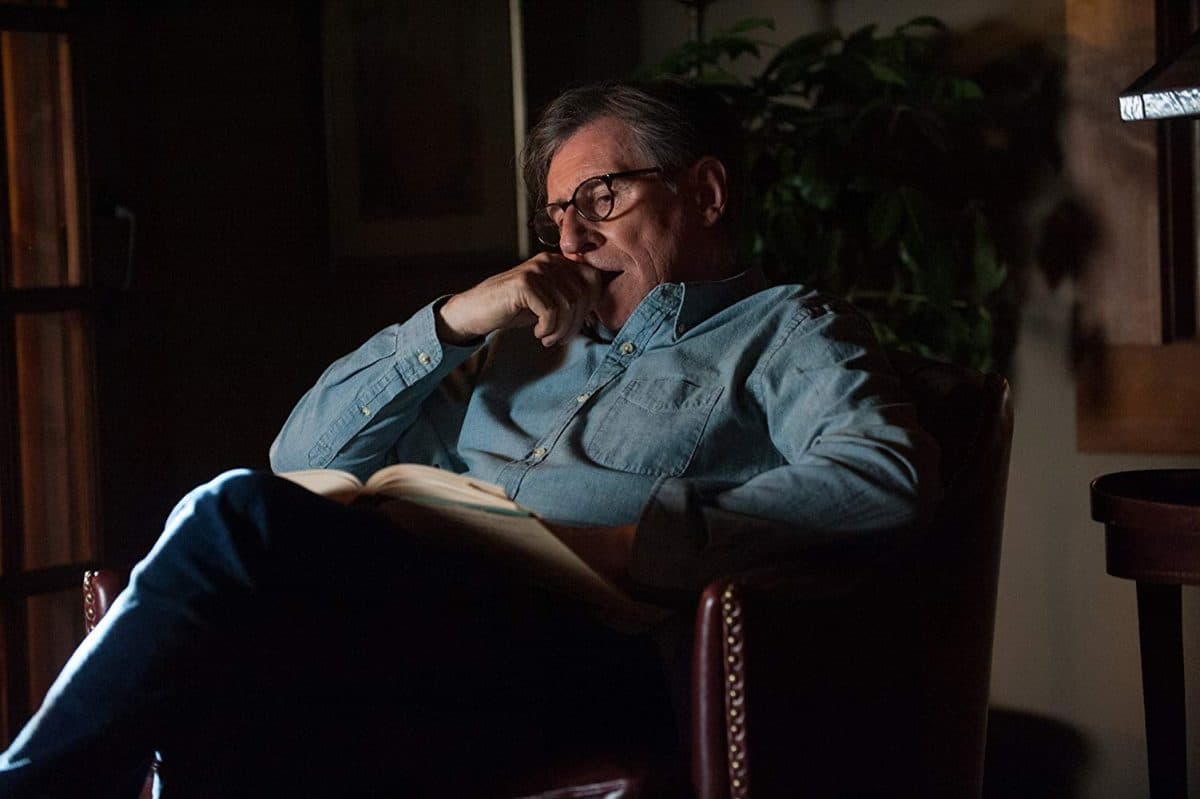
Charlie is making her dolls. She has a compulsive need to click her tongue, which is a harmless sound that will grow to be terrifying later. A strange flash of light glints across the room and seems to “beckon” her outside. Charlie wanders around outside. In a field, she sees what looks like her grandmother in a white dress sitting (with her back to her) in front of a fire. What’s going on?
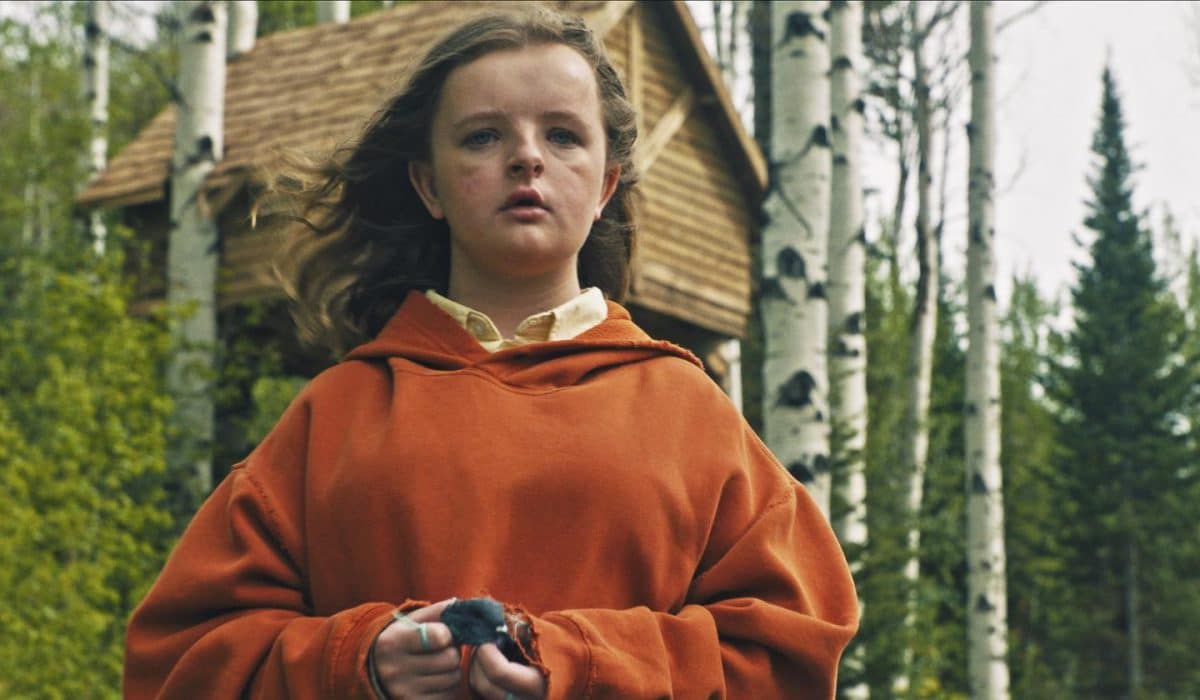
Break into Two: Peter gets a text that there’s a raging party. He asks his mom if he can go. She insists he take Charlie. It’s Annie’s choice (that’s unknown to us at the time) that makes this the Break into Two. This decision kicks off the upside-down world of Act Two, as it will have fatal consequences.
Fun and Games: At the party, Peter goes off to smoke a bowl with some friends, leaving Charlie alone with strangers. Chocolate cake is offered to her. However, the dessert has nuts, to which she’s deathly allergic. After eating the cake, her throat swells up and Peter races with her toward the hospital. Charlie rolls down the window to get air, sticking her head out. However, when Peter swerves to avoid a dead deer in the road, Charlie is decapitated when Peter swipes past a telephone pole.
In shock, Peter drives home and goes to bed, leaving his sister’s headless body in the backseat of the car. Annie discovers her daughter’s corpse and falls into deep sadness and depression. The grief that Annie and the rest of the family experiences begins to tear them apart.
After the funeral, Annie starts sleeping in the treehouse that Charlie used to occupy often, perhaps as a way to feel closer to her.
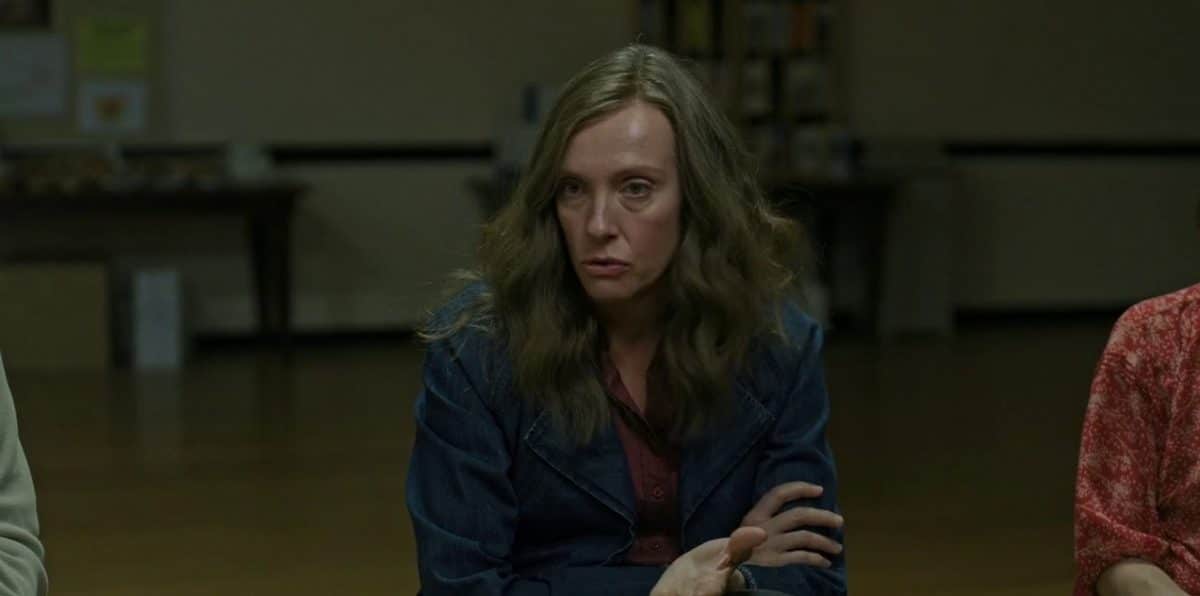
Peter begins to change—he’s becoming more detached. When he’s smoking pot with his friends under the bleachers, he has a reaction of his “throat getting bigger” and can’t breathe, just like Charlie had previously with the chocolate nut cake. He also starts hearing his sister’s incessant habit of “clicking” her tongue.
B Story: Dealing with the grief of Charlie’s loss, Annie returns to the grief recovery group (lying that she’s at the movies). But she can’t go in. Before she can leave, she’s stopped by a woman, Joan (Ann Dowd). Joan reveals that she’s lost her son and grandson in a drowning accident. She offers to help Annie. Though Joan’s motive for helping Anne seems genuinely caring in the beginning, it’s through the course of the film that Joan will help Annie learn the lesson of the theme of not knowing people whom we thought we knew.
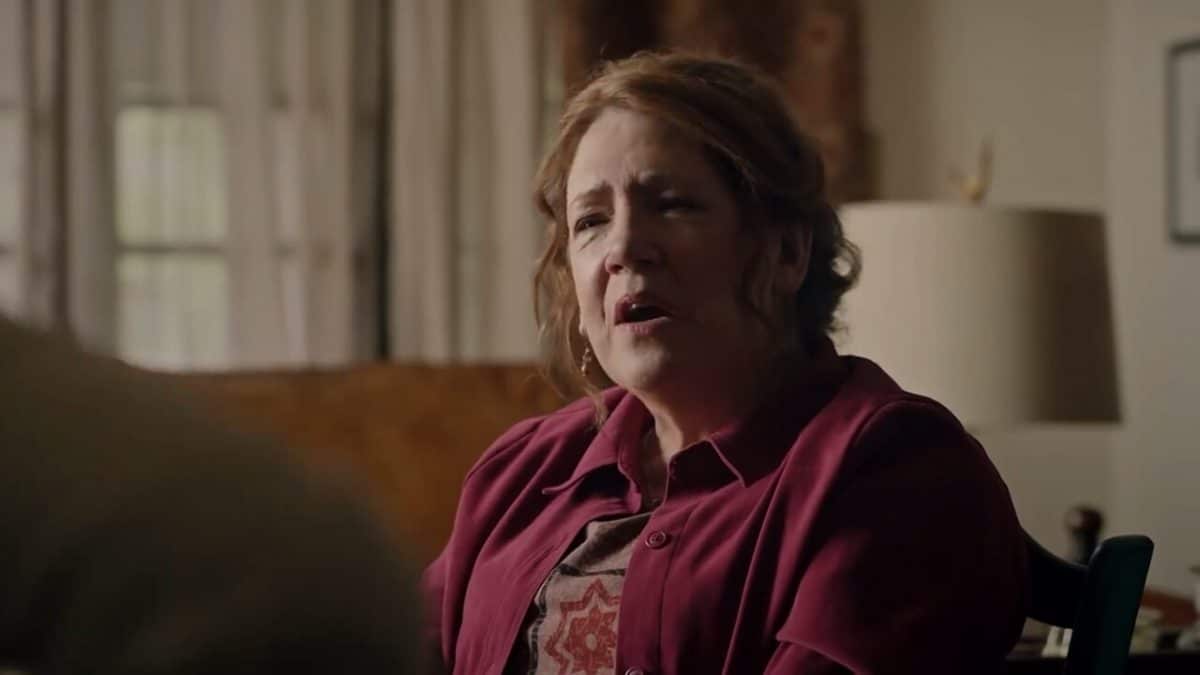
Fun and Games (cont’d): Peter keeps growing more unhinged. He wakes up in the middle of the night and thinks he sees his sister standing in the corner of the dimly lit room. It’s not… for now.

In her workshop, Annie accidentally “spills” some model paint (the bottle topples itself) onto Joan’s phone number. This incites her to reconsider Joan’s offer for help and seek her out. At Joan’s apartment, she notices an embroidered mat. Just like her mother used to make—what a strange coincidence! Annie confides to Joan about finding Charlie’s body, as well as a sleepwalking incident where she woke up in Peter’s bedroom to find herself, Peter, and Charlie covered in paint thinner with a lit match in her hand. It’s an occurrence which Peter still holds against her.
Later, at the family dinner, Annie blows up at Peter—divulging all of her bottled-up anger and resentment toward him regarding Charlie’s death. Peter turns back on her, saying that Charlie didn’t even want to go to the party—that Annie made her go. It’s an ugly scene of how a dysfunctional family deals with grief and loss.
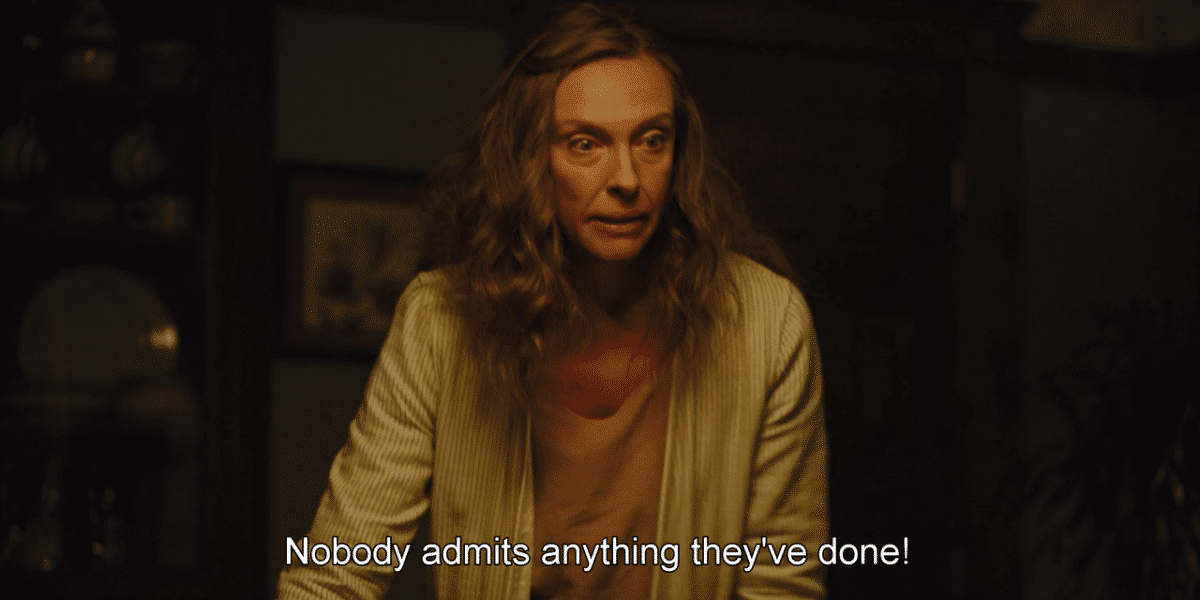
Midpoint: Shopping for art supplies, Annie conveniently “bumps” into Joan. Joan is raving about meeting a spiritual medium and attending an open séance. Joan then reveals that the medium came to her apartment and conjured her grandson’s spirit. Though Annie is skeptical, she accepts Joan’s invitation to join in an afternoon séance. This ties A and B Stories together, as well as raising the stakes (we’ll learn how high later). In a going public moment, Joan speaks with her dead grandson, then teaches Annie how she can speak to Charlie. This is a False Victory for Annie.
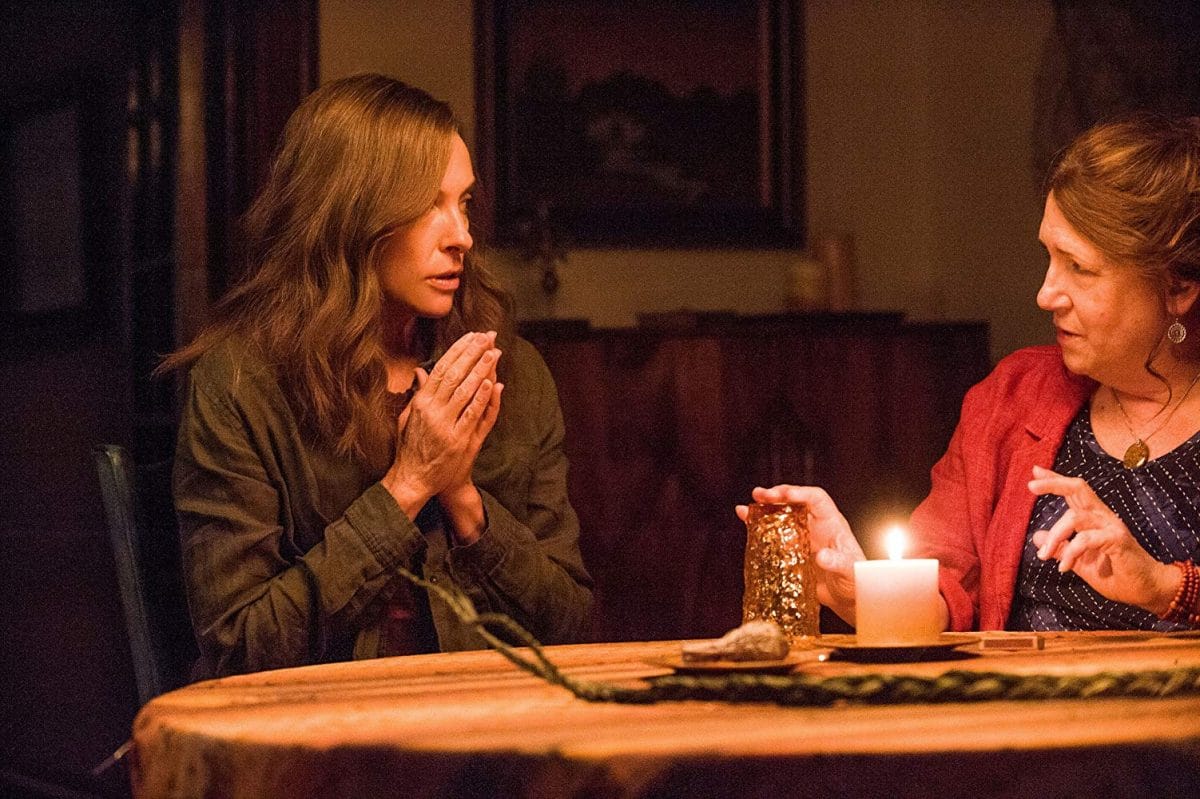
Bad Guys Close In: That night, Annie has a revealing dream, talking to Peter about why she never wanted to be a mother and how her grandmother pressured her into having him. The scene then ends horribly with Peter and Annie soaked in turpentine and she lighting a match.

Annie awakens from the nightmare and successfully contacts Charlie (disintegrating her old beliefs about the supernatural). She then awakens Peter, apologizing to him about dinner, and then Steve to participate (which they do—reluctantly) in a séance. Annie says that she’s a medium and was ignoring the apparitions (of her mother) earlier and that she is able to channel Charlie. She does—and it’s creepy. So much so it upsets Peter, who becomes hysterical. This angers Steve who throws water on Annie to wake her from the spiritual conjuring.
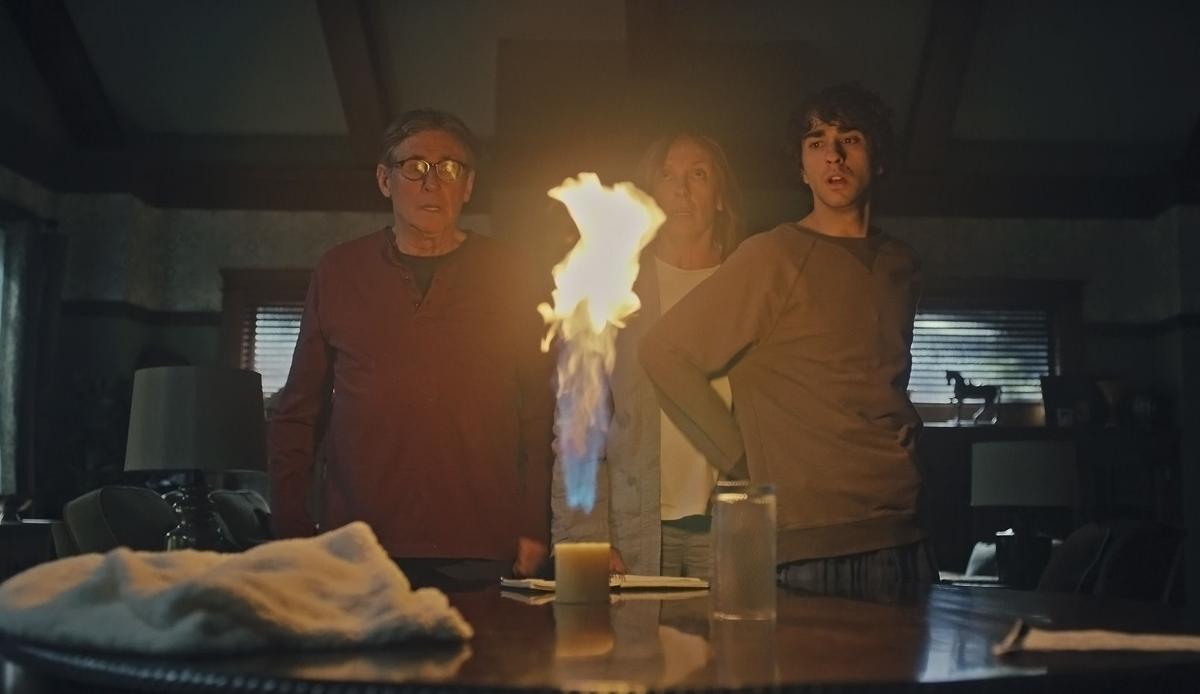
The next day at school, Peter sees the strange light (which Charlie saw earlier before she died) and then sees his own reflection in the glass smiling at himself evilly. He becomes hysterical again, calling Steve, and telling him that he feels like a vengeful spirit is after him. Steve calls Annie and reprimands her for scaring Peter. In a fit of rage, Annie destroys all her miniature art pieces that she’s readying for the gallery. The family unit disintegrates even further in true Bad Guys Close in fashion.
Later that night, Annie finds Charlie’s sketchbook opening. Drawings are appearing in it, drawn by an invisible hand. At the same time, Peter awakens to find Charlie standing in the corner of his room making her trademark clicking noises with her tongue. When she goes to speak, her head falls away, which then becomes a Nerf basketball. False alarm? Hands then grab Peter’s head and seem to try to rip it from his body. Annie awakens him and Peter claims Annie was trying to hurt him, which she denies. The pictures drawn by the invisible hand reveal they’re of Peter with his eyes Xed out.
All Is Lost: Annie tries to burn the sketchbook in the fireplace, but as she does, her arm catches on fire. She and the sketchbook are linked—if she burns it, she burns too. (It seems they linked themselves after Annie used it in the séance, as she opened a portal for a malicious entity.) This is a foreshadowing of things to come and a whiff of death for Annie, which also mirrors the Catalyst of her mother’s death.
Dark Night of the Soul: Annie returns to Joan’s apartment, but her “friend” doesn’t answer. It’s revealed within the apartment that Joan has set up her own séance for Charlie and Peter. Peter’s photo is on the table sitting in the middle of a triangle carved into the wood (this is a portal to summon a spirit) with the eyes Xed out of the photo. Charlie’s homemade dolls with the severed animal heads are also there, complete. Candles burning. The embroidered doormat gives Annie an idea.
At school, Peter sits alone. He starts hearing a voice calling his name—it’s Joan (who he doesn’t know). She says that she expels him and starts chanting words like Zatany! Dagdany! Aparagon! She tells him to get out! (This will all become clear later).
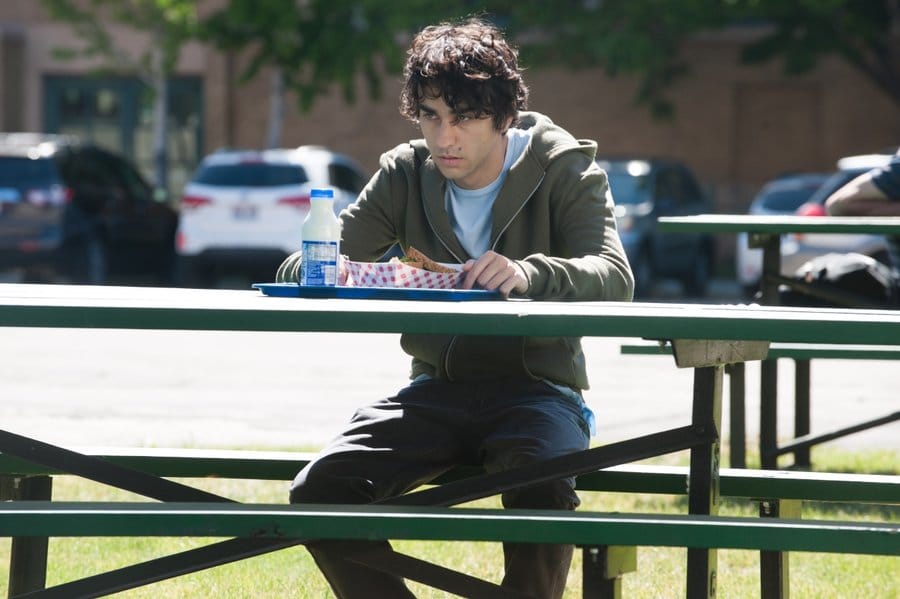
Annie looks through all of her mother’s things. She discovers books on invocations and one with the strange sigil that we’ve been seeing through the course of the film (the sigil of King Paimon, the god of mischief). In a book, she sees that a host is needed, preferably a male one, to summon and lock in Paimon. The results of one doing this successful summoning are riches and desires granted.
Annie then has a moment of clarity where she learns the theme when she sees photos of Joan and her mother together. They’re wearing the sigil of King Paimon. Joan’s “help” all along was a front. She’s a false mentor to Annie. It seems that Annie and her family were targets from these demonists from the beginning. She learns, finally, who her mother really was. This reflects the Debate where all the apparitions and strangeness is explained. Now the stakes are raised even higher.
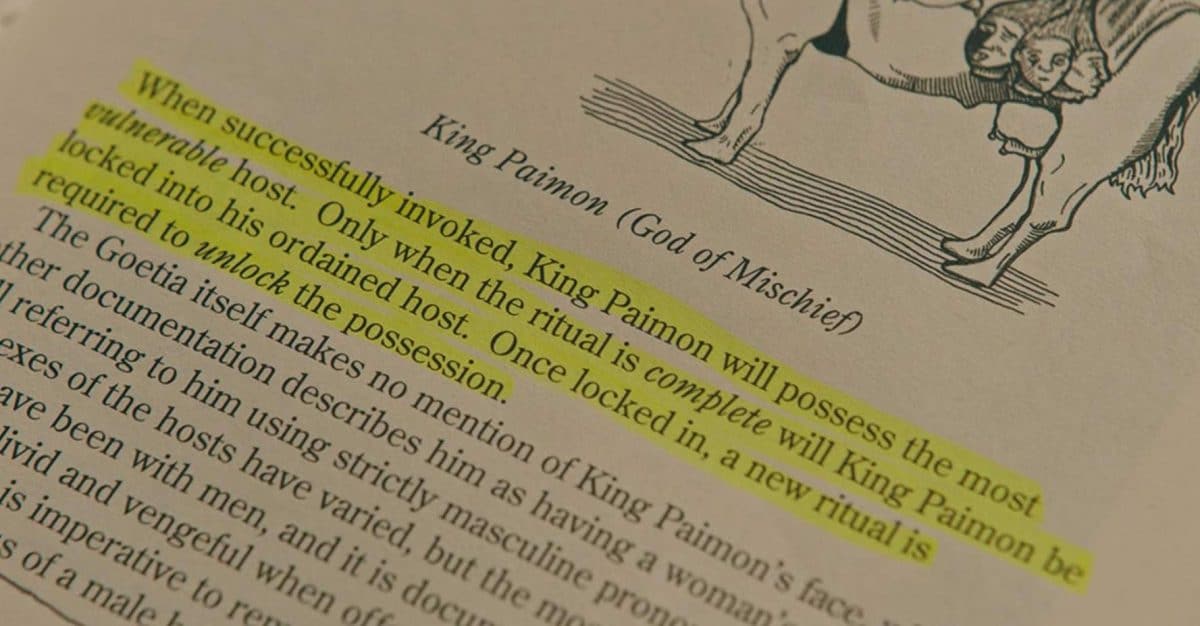
At school, Peter sees the strange glinting light again. And hears his sister’s clicking tongue noise. This time, however, something possesses him, making him smash his face down into a desk. Throughout the film, a strange smell and unexplained flies have inhabited the Graham house. Annie sees the source of it: the attic. When she climbs up there, she finds her mother’s rotting, headless corpse and the sigil of King Paimon etched in blood on the ceiling.
Steve brings Peter home and puts him to bed. Annie shows Steve the attic. He asks why she didn’t call the police. She says that the police can’t do anything—that only she can stop this. She reveals Joan’s insidious plot to Steve, sounding more and more like an unhinged conspiracy theorist. Steve accuses Annie of digging up her mother’s grave during the nights she pretended going to the movies. Annie says that they have a curse on them ever since they conjured Charlie at the séance and now it wants Peter.
Break into Three: Annie says she knows how to stop it—burn the sketchbook as that seems to hold the power. (She learned all this from her association and discovery of who Joan really is, which ties in A and B Stories). She explains that she’s linked to the book, so she can’t burn it, but she douses it in turpentine and asks Steve to. At his wit’s end, Steve mechanically starts to throw the book into the fire, and then he says he’s not having any part of Annie’s insanity anymore, he’s calling the police.
Angry, Annie grabs the book out of his hands and throws it into the fire. Whoosh! To her horror, Steve erupts into a fireball, instead of Annie. And at the same time, the strange glinting light that Charlie and Peter saw previously seems to settle inside Annie, raising the stakes even more.
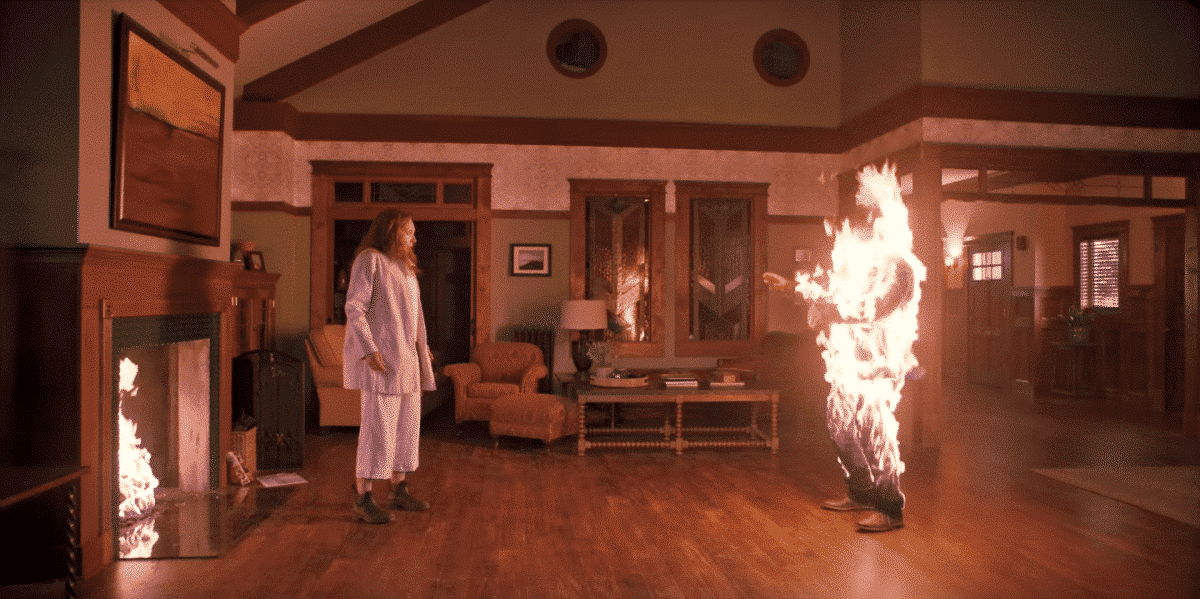
Finale: Peter wakes up to a dark, silent house (he can’t smell the body or the charred corpse of his father as he has a nose plug from smashing his head into the desk). Behind him, levitating, is Annie, who is now possessed by Paimon. Peter discovers his father’s corpse, not only burned to a crisp but now headless too. Demonic Annie attacks him, sending him running up into the attic. Peter sees naked members of the coven (ones we saw earlier at the funeral) up there. They’re naked as part of the demonic ritual.
Possessed Annie somehow finds her way into the attic, and using piano wire, saws off her own head. Peter dives out the window, trying to get away. However, the strange glinting light, which we now understand as the demon, settles into him. Peter rises, now clicking his tongue like Charlie did. He goes into the treehouse. There’s a congregation of naked Paimon disciples kneeling on the floor bowing to something. Peter sees a mannequin of King Paimon, adorned with Charlie’s rotted, severed head (which is a callback to Charlie’s pigeon-headed doll). The headless corpses of his mother and grandmother are at the feet of the altar. A photo on the wall of his grandmother has “Queen Leigh” emblazoned on it.

Final Image: Joan removes the crown from the grisly mannequin’s head and places it on Peter. She then addresses Peter as “Charlie” and says that he’s all right now, and that he’s Paimon, one of the eight kings of Hell. That they “corrected the first female body (Annie) and have given you this healthy male host (Peter).” They ask for His knowledge of all secret things and to bring them honor, wealth, and good familiars; bind all men to their will as they are bound to Him.
The final moment is the worshippers chanting, “Hail, Paimon,” and an extreme wide shot of the interior of the treehouse, which looks much like one of Annie’s miniature dioramas. The transformation is complete—the family unit is no more and only King Paimon stands in its place, just as Annie’s grandmother, Queen Leigh, had intended from the beginning.
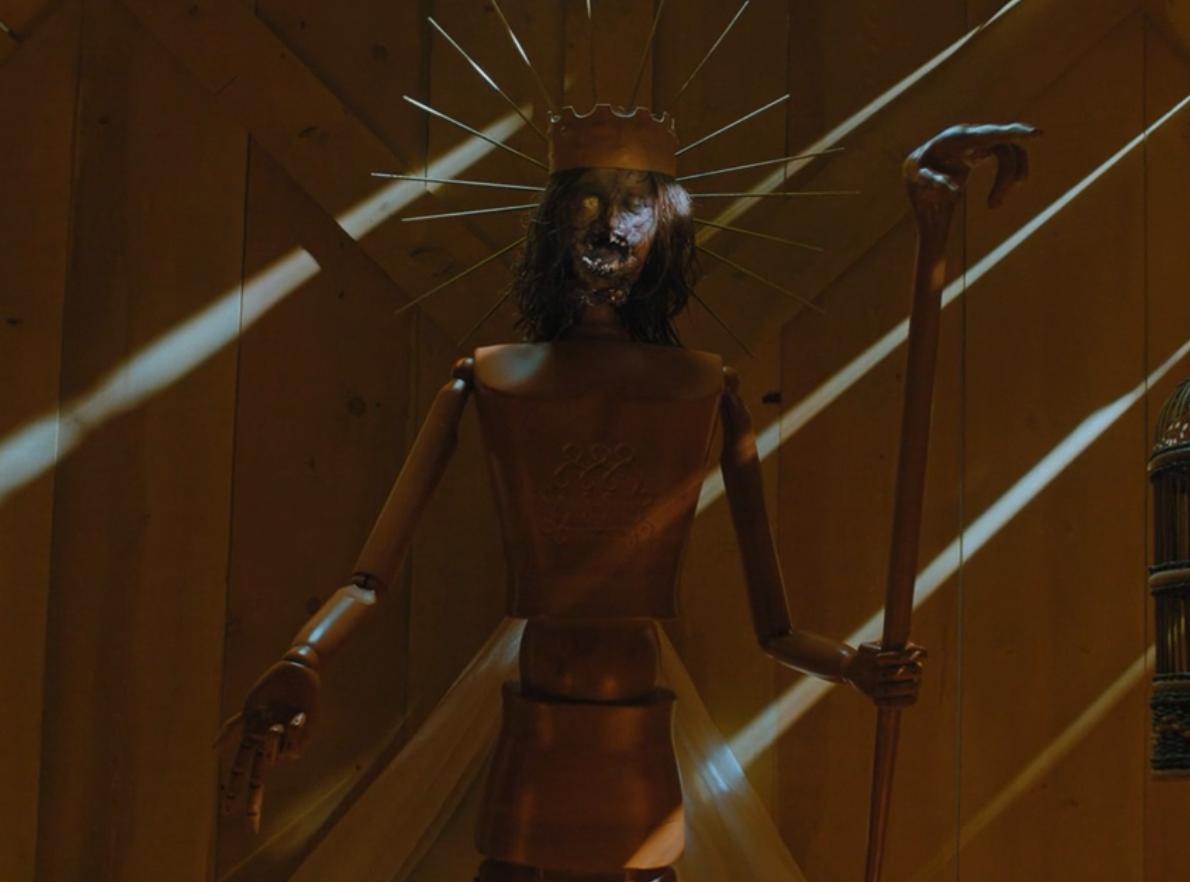

Don Roff
4 Comments
Leave a Reply Cancel reply
You must be logged in to post a comment.



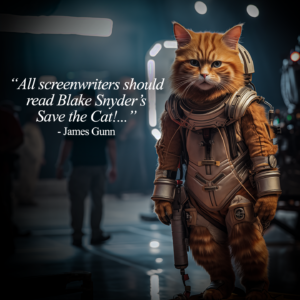






Hi Don! Thank you for this informative beat sheet. I loved Hereditary; it left a permanent mark on me, and I enjoyed your breakdown. I have one question, however, specifically pertaining to the sin factor of this MITH movie:
What is Annie’s sin?
In the case of this film, I initially thought Annie invites the monster into her house when she performs the séance. However, we learn the monster was there well before that all along, and everything was predestined. I recall the movie alludes to the tragic nature of its story and how the protagonists were always doomed from the beginning. So then, was Annie’s sin that she was the daughter of a cult leader?
I’d say this one is a blend of the Supra-Natural MITH and Nihilist MITH. In the latter, there’s not a specific sin committed by the protagonists that triggers the monster; their whole lives and their ignorance/naivete surrounding the monstrous world around them are “sinful” inherently.
That’s a great point, Ethan. I’ve been thinking about doing a Nihilist MITH like AUDITION or THE STRANGERS. Still may do a study in the future, we’ll see. Thanks for reading!
Great question, Jaho! In this case, Annie doesn’t have much of a transgression to speak of here. It’s more her mother who conjures the evil into the Graham household (as was her plan all along). In the MITH genre, there always has to be a sin or transgression, but it’s not always with the protagonist. That’s ideal, of course, but not always necessary. In the case of JAWS, a Pure Monster MITH, Chief Brody is trying to close the beaches on Amity Island where Mayor Vaughn is forcing them to stay open for commerce; greed being his sin. In ROSEMARY’S BABY (an obvious HEREDITARY influence), it’s husband Guy Woodhouse, and not the protagonist Rosemary Woodhouse, who commits the sin to bring forth the monster (also for greed’s sake). Whenever I’m studying a story to see if it’s a MITH, the first thing I always look for is a transgression, either in the main character, or in a supporting character that has brought the monster. It’s gotta be *someone’s* fault. Thanks for reading!